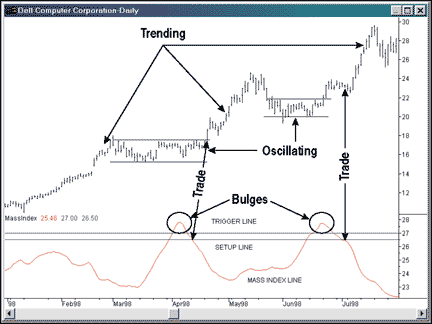TRADING TECHNIQUES
Detecting New Trends Early
by David R. Steckler
Finding a trend early is a primary goal for many traders. Here's a technique developed for stocks that can work for any instrument with volume information, using a combination of mass index and money flow index.
Everyone enjoys buying a stock just at the start of an explosive move up. But how do you find those opportunities? For a number of years, I've used a combination of Donald Dorsey's mass index and Brian Green's money flow index to identify conditions that improve the likelihood of finding a stock with the potential for rapid price appreciation. The earlier you get in on these breakout moves, the greater your chances for maximizing potential gains.

FIGURE 1: DELL, MASS INDEX. The mass index forms a bulge over its setup and trigger lines as daily range expands.Big moves occur when a stock breaks out of a trading range and begins to trend. Stocks trend higher when, over a defined period, they make a series of higher lows followed by higher highs.
Trading within a price range is also known as nontrending or oscillating price action. A common form of range-trading occurs when a stock makes a series of similar highs, followed by a series of similar lows. This pattern of trading within a range is also known as a rectangular base or consolidation range.
Buying a stock when it starts to move from an oscillating state to a trending state attempts to get you into a position at the beginning of the trend, maximizing your opportunity for profits. Now, let's see how the mass index helps with this.
MASS INDEX
The mass index indicator, developed by Donald Dorsey, is used to warn of an impending direction change. (See the sidebar "The mass index and moving average formulas" for details of the computation.)
The mass index plots three lines: a setup, a trigger, and a mass index. The setup and trigger lines are fixed and appear as horizontal lines on the chart. The mass index line itself varies as the daily range changes. According to Dorsey, the most important pattern in range oscillation analysis is the reversal bulge, a gradual but definite increase of the average daily range that indicates the market is near a turning point.
When looking at the mass index in Figure 1, you see a wandering mass index line below the setup and trigger lines. An actionable signal is generated when the mass index line rises from below through both the setup and trigger lines and then crosses back through from above, creating what appears to be a bulge through the lines.
Figure 1 displays how Dell's sideways motion progressed as the mass index line rose through both the setup and trigger lines, then fell back below both lines. In theory, when the mass index crosses back through both trigger and setup, a trend has begun and a position in the stock should be initiated once the stock breaks out of the consolidation range. In both rectangular base time periods, Dell broke out within a few days after the trigger completed its bulge and fell back through the setup. Nevertheless, I've found that by itself, the mass index is not enough to identify trend reliably.
David R. Steckler trained as a lawyer but has instead traded stocks and commodities since 1989. He may be reached via E-mail at DSteckler@aol.com.
Excerpted from an article originally published in the November 1999 issue of Technical Analysis of STOCKS & COMMODITIES magazine. All rights reserved. © Copyright 1999, Technical Analysis, Inc.
Return to November 1999 Contents